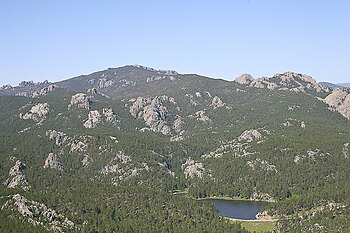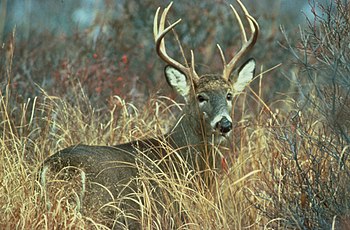 |
| (Photo credit: Wikipedia) |
MADISON - As one of the harshest winters on record continues its icy grip on Wisconsin state wildlife officials are monitoring its effects on wildlife, particularly deer and turkey.
"We have received some reports of dead deer and turkey, especially in northern Wisconsin where snow is more than 30 inches deep in some areas," said Tom Hauge, director of wildlife management for the Department of Natural Resources.
While animals native to Wisconsin are equipped to handle snow and cold, too much for too long can overwhelm an individual animal's resources.
DNR biologists use a "winter severity index" to gauge winter stress levels. Points are assigned for each day with snow deeper than 18 inches and temperatures below zero. WSI measurements are recorded at 43 stations across the northern third of the state and in several east-central counties. Winter conditions are considered mild if a station accumulates less than 50 points, moderate between 51 and 80 points, severe between 81 and 100, and very severe if more than 100.
Many stations in northwestern counties have already reached "severe" on the index, said Mike Zeckmeister, DNR northern wildlife supervisor and more stations likely will record a severe winter index in coming weeks. The
2013-2014 Winter Severity Index [PDF] is available on the DNR website.
People asked to report any deer mortalities
DNR biologists are asking the public to report any observations of winter deer mortality. The reports can be submitted through the DNR website by searching for keywords "
dead deer."
Concerned citizens can also search the DNR staff directory for local wildlife biologists and technicians to receive their reports. Additionally, DNR biologists are working in the field this time of year, monitoring deer and their habitats and talking to loggers, foresters, trappers and others who frequent the winter woods.
Sam Jonas, DNR wildlife biologist for Iron County surveyed a 4-mile stretch near the Wisconsin-Michigan border that runs through a wintering area and observed about 70 deer and 16 turkeys.
"The deer are browsing cedar, hemlock and other brush in area," Jonas said. "I am sure we do have some winter mortality in areas, however, the deer I have seen in this wintering area look like they are faring pretty well so far, including the fawns. Late March and April is historically when we see winter mortality so I will be doing a lot of snowshoeing into deer yards at that time to check on things."
Conditions generate questions about feeding deer
The harsh winter is generating questions from the public about feeding deer. Zeckmeister said it is a legitimate and compassionate inquiry but one without an easy answer.
"I understand people want to try to help deer through a hard winter, but feeding can do more harm than good," he said.
Feeding unmixed corn or hay can actually be harmful to deer in late winter. A commercialized pellet - or mixes containing small quantities of corn, plus alfalfa, oats and soybeans, as well as various vitamins and minerals - is the best choice. The food should be spread out to reduce fighting, kept away from roads or snowmobile trails to avoid collisions, and placed near areas sheltered from the wind.
Deer feeding is regulated under Wisconsin law and is prohibited in counties affected by chronic wasting disease. In all other counties, feeding is limited to a maximum of 2 gallons per site. Feeding sites must be placed within 50 yards of a dwelling or a business building open to the public and may not be placed within 100 yards of a roadway with a posted speed limit of 45 mph or higher.
Conditions to have impact on deer permit levels
"There is no question this winter will affect decisions concerning the deer season," said Kevin Wallenfang, DNR big game ecologist. "We are watching this very closely and will adjust the 2014 antlerless deer quotas in response. Based upon what we've seen to date, northern Wisconsin deer hunters can expect to see a lot of buck-only units this fall. The availability of antlerless permits will be extremely low or at zero across the north, depending on the area."
Severe winter also having impact on turkey flocks
"This has been a tough winter for many of our resident wildlife species, and turkeys are no exception," said Scott Walter, DNR upland wildlife ecologist. "Although turkeys are very capable of surviving brief periods of cold and snow, the longer those conditions last the more likely it is that we'll see mortalities, and we've already had verified reports of weather-related mortality in at least a few northern counties. Young birds are likely to be the hardest hit, as they don't have the fat reserves that allow adults to survive up to four weeks with minimal food."
The cold forces turkeys to either increase their food intake or burn more of their fat reserves to stay warm while deep or crusted snow makes it difficult to locate food on the ground. Powdery snow more than12 inches deep makes it difficult for turkeys to travel in search of food.
Permit levels can be safely maintained despite population shifts
As a result of poor production last spring and a severe winter, hunters might see fewer turkeys during the spring 2014 season.
"The levels of harvest that typify Wisconsin's spring and fall turkey seasons have little impact on population trends, however," Scott said. "Some hunters understandably have suggested reducing harvest during the upcoming spring and fall to help turkeys recover. Reducing permit levels, however, would greatly reduce hunter opportunity while doing little to help turkey populations."
Landowners interested in habitat enhancements to buffer turkeys against the effects of severe winter weather can receive grain seed for winter plots through the National Wild Turkey Federation Conservation Seed Program, which provides outdated corn as well as sorghum, highbush cranberry and flowering crab seedlings to federation members for reduced costs.
"These programs allow National Wild Turkey Federation members to make a significant contribution to wild turkey winter survival in the Upper Midwest," said Rick Horton, National Wild Turkey Federation Midwest Conservation Field Supervisor.
More information about Wisconsin's wild turkeys is on the DNR website,
dnr.wi.gov, keyword "
turkey."
FOR MORE INFORMATION: on northern deer herd contact Mike Zeckmeister, DNR northern wildlife management supervisor, 715-635-4090; Tom Hauge, DNR wildlife management bureau director, 608-266-2193, or Sam Jonas, DNR wildlife biologist, 715-476-7843; on turkey contact Scott Walter, upland wildlife biologists at 608-267-7861























